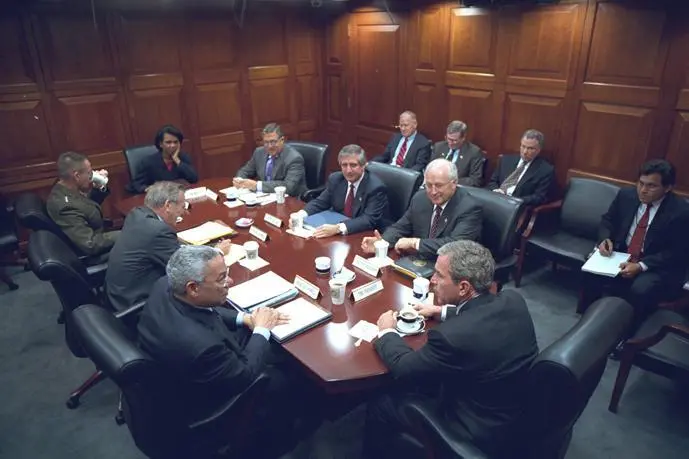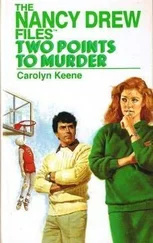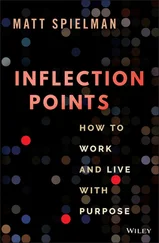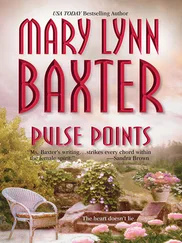The next morning, I squeezed into a blue tent at the Ritz-Carlton with Colin Powell, Condi Rice, Andy Card, and the CIA briefer. The structure was designed to protect the national security briefing from potential eavesdroppers. We turned on a video monitor and Dick Cheney’s face popped up from New York City. He was wearing white tie and tails for his speech at the Alfred E. Smith Memorial Foundation Dinner, an annual charity event organized by the Catholic archdiocese.
As soon as I saw Dick, I could tell something was wrong. His face was as white as his tie.
“Mr. President,” he said, “one of the bio-detectors went off at the White House. They found traces of botulinum toxin. The chances are we’ve all been exposed.”
The CIA had briefed me on botulinum toxin. It was one of the world’s most poisonous substances. Nobody said a word. Finally, Colin asked, “What’s the time of exposure?” Was he doing the mental math, trying to figure out how long it had been since he was last in the White House?
Deputy National Security Adviser Steve Hadley explained that the FBI was testing the suspicious substance on mice. The next twenty-four hours would be crucial. If the mice were still scurrying around, feet down, we would be fine. But if the mice were on their backs, feet up, we were goners. Condi tried to lighten the mood. “Well,” she said, “this is one way to die for your country.”
I went to the summit meetings and awaited the test results. The next day, Condi got a message that Steve was trying to reach her. “I guess this is the call,” she said. After a few minutes, Condi came back with the news.
“Feet down, not feet up,” she said. It was a false alarm.

Years later, incidents like the botulinum toxin scare can seem fanciful and far-fetched. It’s easy to chuckle at the image of America’s most senior officials praying for lab mice to stay upright. But at the time, the threats were urgent and real. Six mornings a week, George Tenet and the CIA briefed me on what they called the Threat Matrix, a summary of of potential attacks on the homeland. On Sundays, I received a written intelligence briefing. Between 9/11 and mid-2003, the CIA reported to me on an average of 400 specific threats each month. The CIA tracked more than twenty separate alleged large-scale attack plots, ranging from possible chemical and biological weapons operations in Europe to potential homeland attacks involved sleeper operatives. Some reports mentioned specific targets, including major landmarks, military bases, universities, and shopping malls. For months after 9/11, I would wake up in the middle of the night worried about what I had read.
I peppered my briefers with questions. How credible was each threat? What had we done to follow up on a lead? Each piece of information was like a tile in a mosaic. In late September, FBI Director Bob Mueller inserted a big tile when he told me there were 331 potential al Qaeda operatives inside the United States. The overall image was unmistakable: The prospect of a second wave of terrorist attacks against America was very real.

With the national security team in the Situation Room in late October 2001. Clockwise from me: Colin Powell, Don Rumsfeld, Pete Pace,
Condi Rice, George Tenet, Andy Card, and Dick Cheney. White House/Eric Draper
Prior to 9/11, many had viewed terrorism primarily as a crime to be prosecuted, as the government had after the bombing of the World Trade Center in 1993. After 9/11, it was clear that the attacks on our embassies in East Africa and on the USS Cole were more than isolated crimes. They were a warm-up for September 11, part of a master plan orchestrated by Osama bin Laden, who had issued a religious edict, known as a fatwa, calling the murder of Americans “an individual duty for every Muslim who can do it in any country in which it is possible to do it.”
On 9/11, it was obvious the law enforcement approach to terrorism had failed. Suicidal men willing to fly passenger planes into buildings were not common criminals. They could not be deterred by the threat of prosecution. They had declared war on America. To protect the country, we had to wage war against the terrorists.
The war would be different from any America had fought in the past. We had to uncover the terrorists’ plots. We had to track their movements and disrupt their operations. We had to cut off their money and deprive them of their safe havens. And we had to do it all under the threat of another attack. The terrorists had made our homefront a battleground. Putting America on a war footing was one of the most important decisions of my presidency.
My authority to conduct the war on terror came from two sources. One was Article II of the Constitution, which entrusts the president with wartime powers as commander in chief. The other was a congressional war resolution passed three days after 9/11. By a vote of 98 to 0 in the Senate and 420 to 1 in the House, Congress declared: That the President is authorized to use all necessary and appropriate force against those nations, organizations, or persons he determines planned, authorized, committed, or aided the terrorist attacks that occurred on September 11, 2001, or harbored such organizations or persons, in order to prevent any future acts of international terrorism against the United States by such nations, organizations, or persons.
In the years ahead, some in Congress would forget those words. I never did. I woke up every morning thinking about the danger we faced and the responsibilities I carried. I was also keenly aware that presidents had a history of overreaching during war. John Adams signed the Alien and Sedition Acts, which banned public dissent. Abraham Lincoln suspended habeas corpus during the Civil War. Franklin Roosevelt ordered Japanese Americans interned during World War II. When I took the oath of office, I swore to “preserve, protect, and defend the Constitution.” My most solemn duty, the calling of my presidency, was to protect America—within the authority granted to me by the Constitution.

The immediate task after 9/11 was to harden our nation’s defenses against a second attack. The undertaking was daunting. To stop the enemy, we had to be right 100 percent of the time. To harm us, they had to succeed only once.
We implemented a flurry of new security measures. I approved the deployment of National Guard forces to airports, put more air marshals on planes, required airlines to harden cockpit doors, and tightened procedures for granting visas and screening passengers. Working with state and local governments and the private sector, we increased security at seaports, bridges, nuclear power plants, and other vulnerable infrastructure.
Shortly after 9/11, I appointed Governor Tom Ridge of Pennsylvania to a new senior White House position overseeing our homeland security effort. Tom brought valuable management experience, but by early 2002, it had become clear that the task was too large to be coordinated out of a small White House office. Dozens of different federal agencies shared responsibility for securing the homeland. The patchwork approach was inefficient, and there was too much risk that something would slip through the seams. One egregious example came in March 2002, when the Immigration and Naturalization Service (INS) mailed a letter notifying a Florida flight school that it had granted student visas to Mohamed Atta and Marwan al Shehhi. The person opening the letter must have been shocked. Those were the two pilots who had flown airplanes into the Twin Towers on 9/11.
Читать дальше













